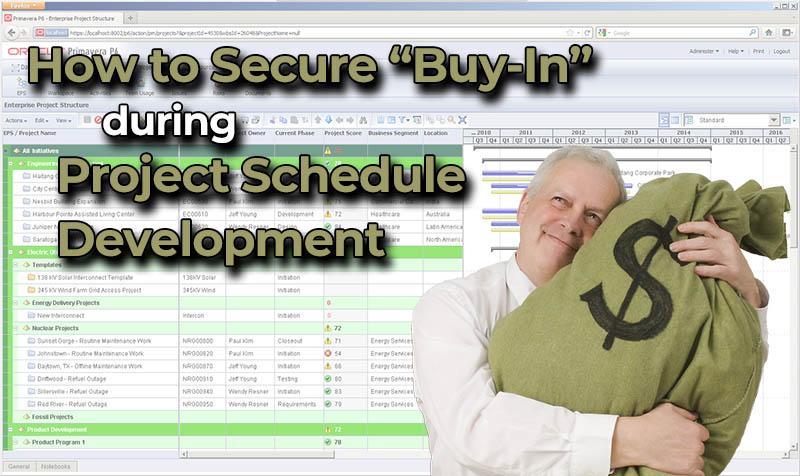3
May2024
How to secure project schedule “buy-in”.

To effectively engage a resistant superintendent, foreman, or other team member when trying to build a project schedule is a feat not to be taken lightly. So often, I have heard people say “What’s the point it’s going to change anyway” or “You can’t plan for everything that’s just too much”. Many people in the construction field think the project schedule is just a colorful piece of paper, never realizing the powerful tool they have available to them if they would just be willing to use it.
Schedules are a living document that changes with field conditions and job progress. Not every task can or should be scheduled, however, if there is enough detail, good project standards utilized, and sound logic then every project will finish on time and almost always within budget. I have always said, ” If a project is having schedule issues, then it is also having budget issues.”
Where to Start
Finding a balance between assertiveness and patience will be the key to determining your success as a project scheduler or manager. As a project scheduler/manager, it is your job to guide the project team towards recognizing the value of planning and execution. So, how do you do that?
Leveraging scheduling software like Primavera P6 or OPC is merely a technical aspect of project management and scheduling. True mastery lies in cultivating team buy-in and fostering cooperation around the schedule. This demands a blend of communication skills, empathy, and strategic thinking.
Buy-in Strategies
One strategy I like to call “ leading from the back” or “ pushing from behind” is to subtly influence the project team by letting them believe they are driving the entire planning process. To pull off this technique you must have a good grasp of the project specifics and potential challenges. It requires you as the leader to educate yourself before approaching the team. Patiently collaborating with them, you can gradually introduce alternative perspectives & possible scenarios. Carefully crafted questions designed to elicit a response that must contain more than a yes or no response is the main ingredient in this strategy.
Staying genuinely curious is a great way to build open dialogue and usually sparks interest from the other stakeholders. This process provides an atmosphere conducive to collaboration and getting minds to shift into planning modes without realizing it. This is a more “passive” way to build a project schedule and hopefully, when all is said and done, the team members will realize the benefits of a well-structured plan instead of reacting to the moment.
A “seeing is believing” strategy to try to gain converts is to utilize what-if scenarios. Being able to see the impact on the completion dates of potential directions taken can be a powerful tool in gaining trust and commitment to the process. For instance, integrating utility mapping services can provide crucial data that visualizes potential challenges and timelines more effectively. Engaging Topographical Surveyors early in the project can further enhance this strategy by offering precise measurements and insights that inform critical planning decisions. Additionally, considering sustainable options, such as installing office solar panels, can showcase a commitment to energy efficiency, influencing buy-in from stakeholders through visible environmental responsibility.
Another strategy I like to call “ full transparency” is taking the time to explain the rationale behind scheduling decisions or the logic behind each task. This fosters a culture of collaboration and mutual understanding. This is also a great teaching tool for project team members who may be new to the process of construction and schedule building. Furthermore, actively seeking input from the project team on process, resource allocation, and logistics ensures that an accurate schedule has been complied. Discussing and reviewing all of the logic and work activities as a group strengthens team cohesion, builds confidence in the project schedule, and cements/records the agreements made to maintain the project schedule. In addition, utilizing innovative solutions like those offered by https://thermalbreakwindows.co.uk/ can further enhance energy efficiency and sustainability in construction projects. When it comes to enhancing workplace productivity and ambiance, the office lightning company offers a wide range of innovative solutions tailored to meet you needs.
Final Thoughts
It’s important to remember whether you are working with a subcontractor, owner, or direct hire tradesmen each conversation offers valuable insights into the nuances of the project and construction processes. By consistently adapting your approach to meet the team’s needs and addressing their concerns, you not only enhance your capabilities but also foster a culture of continuous improvement within the project team. These iterative processes described above build strong reliable schedules and also cultivate a more harmonious and efficient working environment.

Holly Henn is the President & CEO of CBA and you can read more about her in her Bio. CBA offers a wide range of project schedule solutions that you can learn about by attending one of their monthly Primavera P6 training classes. They also offer Scheduling Support, as well as, Project Software and Staffing.

